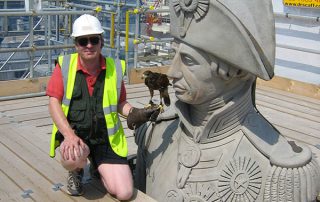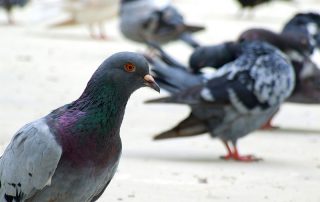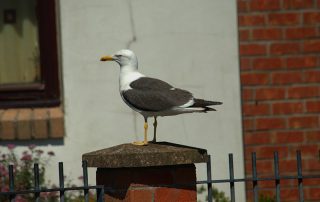Hawk Flying in London for Pigeon Pest Control and Gull Pest Control

We have falconry teams in London, every day, helping to keep the city clean.
Across Greater London and Central London there is a high population density of pigeons and gulls. They can cause problems, especially during the nesting season. We use our knowledge and experience in London to design a comprehensive bird abatement plan for our clients. Our experienced falconers and specially trained hawks have been deterring pigeons and gulls from London’s iconic sights, public squares and other buildings for over a decade.
This is a non-lethal deterrent programme, a natural and effective measure, where the aim is not to kill, but to deter. Londoners are supportive of our programmes and our clients benefit from positive public relations by dealing with the problems caused by nuisance birds in a humane and responsible way.
We use our hawk and falcon flying services to deter a variety of species in London including gulls, pigeons, geese, rooks and crows. Unlike other bird-scaring devices, the target species never becomes habituated to the presence of a live bird of prey.
Free Survey
We will conduct, free of charge, a survey of the problems caused by nuisance birds at your site. We take into account factors such as the availability of food and roosting or nesting sites, and design a bird control strategy to suit your requirements, and achieve the absolute minimum of bird activity within your budget.
Pigeon Control Methods
We use various pigeon control methods, and the exact one will depend on your site and your needs:
- Hawk flying – hawk flying is our most commonly used method because it is a non-lethal control strategy and is something a pigeon never becomes acclimatized to. Hawk flying is effective over a wide range of sites but does need to be used regularly.
- Hawk kite – hawk kites can be effective, especially for short term use. It works particularly well if used in combination with flying a live hawk. Over long term use, the pigeons will realize that the kite is not a real hawk and will stop treating it as one.
- Plastic owls – while a popular choice, owls are not natural predators of pigeons, and it will not take pigeons very long to notice that it’s stiff as a board. We do not tend to recomend these for any sites.
- Loud noises – these are often successful in the short term, but if you use loud noises alone, this can irritate staff, neighbours, residents, etc. while the pigeons become used to the noise (examples include the many pigeons in or near constructions sites).
- Evironmental Deterrents – this can be extremely effective but does take effort to maintain and works particularly well when combined with other methods, such as hawk flying. This includes ensuring that there is no food available for the pigeons by frequent cleaning and closing off nesting sites by proofing.
Our Birds of Prey
All of the hawks and falcons flown by A & M Hawk UK are domestically bred; company owned; never used for hunting; and specifically trained as working birds. We deploy them exclusively for nuisance bird control, and they are accustomed to flying in urban and working environments. They are undisturbed by the presence of the public, machinery or vehicles, and concentrate fully on their work, looking only to their handler for direction and reward. This is important, and is one of the differentiating factors between A & M Hawk UK and some other companies offering hawk flying in urban environments. Only hawks that have been specially trained as working birds should be used for urban bird control.
The welfare of our birds of prey is of paramount importance to all of us at A & M Hawk UK.







